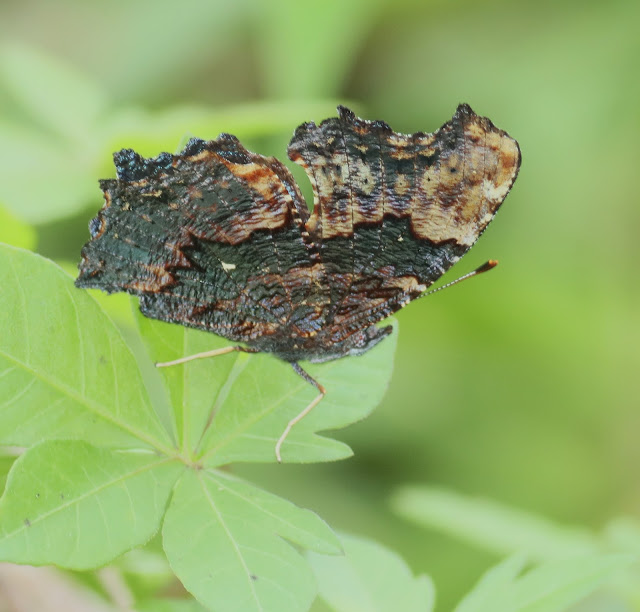Welcome back to a brand new year !! Hope things will get better this year especially in terms of spotting some rare and colourful butterflies. Weather has been unpredictable in January 2023 - mostly cloudy and windy with some rain in the evening. I managed to get some rare butterflies to start the new year and also I would like to share some field marks of a few "difficult" butterflies.
Let me start with this pristine and colourful female Blue Pansy (Junonia orithya wallacei) 
It was seen on some plains with tall weeds in the Northern state of Kedah.
This is a female Chocolate Soldier (Junonia iphita horsfieldi). It was seen in the jungles of Pahang.
This is a White-bar Bush Brown (Mycalesis anaxias senoi)
This species is more common up on the hilly terrains than in lowland forest.
Malayan Wanderer (Parenonia valeria lutescens)
This one was seen near the GAP.
Here is a rare butterfly which ventured into a wrong place.
Taraka hamada mendesia (Forest Pierrot)
We released it after taking its photo. Nevertheless it was a significant find due to its rarity status.
Here is another forest dweller.
Common Faun (Faunis canens arcesilas) - male
Common Faun (Faunis canens arcesilas) - Female
Dark Archduke (Lexia dirtea merguia) - female
This species can only be seen mostly in a dense forest areas.
Yellow Glassy Tiger (Parantica aspasia aspasia)
Quite common here but apparently rare in Singapore. Here it is seen with the flowers of Siam Weed (Chromolaena odorata) which is reported to have originated from the Americas and its poisonous.
Here is another species which was seen near the Siam Weed.
Continental Swift (Parnara ganga ganga)
It can be identified from its very short antenna and larger hyaline spots.
Indigo Flash (Rapala varuna orseis)
This is the first time I am able to see its upperside colours.
I believe this is a Lesser Dart (Potanthus omaha omaha)
A Potanthus omaha couple I think.
Common Four-Ring Common Five-Ring (Ypthima huebneri) (Yphtima newboldi)
Here comes the tiny ones and the blues.

 Lesser Grass Blue
Lesser Grass Blue (
Zizina otis lampa)
Tailless Line Blue (Prosotas dubiosa lumpura)
Barred Line Blue (Prosotas aluta nanda) and Common Hedge Blue (Acytolepis puspa lambi)
Cycad Blue (
Luthrodes pandava pandava)
Rounded Six-Line Blue (
Nacaduba berenice icena)
Rounded Six-Line Blue (Nacaduba berenice icena)

 Common Line Blue
Common Line Blue (
Prosotas nora superdates) - female
Pointed Ciliate Blue (Anthene lycaenina miya)
Malayan Four-Line Blue (Nacaduba pendleburyi)
Okay ! now we go into the comparisons of some quite common but can be 'difficult' species.
Glassy Cerulean (male)
Malaccan Cerulean (Female)
(Jamides parasaturatus) (Jamides malaccanus)
Common Cearulean (Jamides celeno aelianus)
Banded Demon (Notocrypta paralysos varians)
As mentioned in the CP5 field handbook, it has a white hyaline dot in space 4.
What about this one below here.
I believe it could be a Clavate Banded Demon (Notocrypta clavata clavata)
According to CP5 again, there is no spot in space 4 in the male.
How about this one?
No hyaline spots and white discal band did not reach the costal space.
So could it be a N. paralysos or perhaps a N. clavata ?
Lastly here comes the very rare ones.
White Club Flitter / Brush Flitter (Hyarotis microsticta microstictum)
Although the literature says that this skipper is rare but I think it's more like uncommon cause it can be seen occasionally at my local patch. So looks like it's more of a localised species.
The next one is my lifer and probably a rare one.
Initially I thought it could be a Notocrypta quadrata but after looking at its whitish antenna, this is most likely a Demon Flitter (Oerane microthyrus neaera)
Demon Flitter (Oerane microthyrus neaera)
The best thing about this skipper is that it was found in a nearby forest and not in a deep forest.
The next one is also a super rare species.
Initially I reckoned that it could be a Poritia phama rajata based on the two dots on its FW. But after reviewing all the images further I guess it is a "Green Gem" (Poritia pleurata). Both are super rare ones.
Green Gem Poritia pleurata
Although it looks tattered but it can still be identified.
So lucky to get this defining shot.
It perched quite a distance away, so most of the shots are not as sharp as I wish.
In case you are visiting Peninsular Malaysia to view the various endemic / common butterflies, this is a general diagram / outline of the terrains where you can find them.
TILL THEN - ADIOS AMIGOS !
ENJOY THE BEAUTY OF THE BUTTERFLIES WHEREVER YOU MAYBE!








































































.JPG)